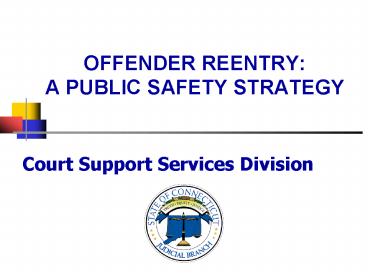OFFENDER REENTRY: A PUBLIC SAFETY STRATEGY - PowerPoint PPT Presentation
Title:
OFFENDER REENTRY: A PUBLIC SAFETY STRATEGY
Description:
Lower recidivism. Reduced violations. Decreased victimization. Reduced ... Some Examples (% Reduction in Recidivism) Intensive Supervision and Treatment (21.9 ... – PowerPoint PPT presentation
Number of Views:56
Avg rating:3.0/5.0
Title: OFFENDER REENTRY: A PUBLIC SAFETY STRATEGY
1
OFFENDER REENTRY A PUBLIC SAFETY STRATEGY
Court Support Services Division
2
OFFENDER REENTRY IMPROVING PUBLIC SAFETY
- Probation Areas of Focus
- Manageable Caseloads
- Programs and Treatment
- Warrant Service
3
OFFENDER REENTRY
- Strategies, programs and treatment that focus on
preparing probationers to lead non-criminal lives
in our local communities.
4
REENTRY THROUGH PROBATION SUPERVISION
- There are approximately 57,000 offenders serving
a term of probation. - There are approximately 11,500 split sentence
cases currently under probation supervision. - In 2006, 5,400 offenders were placed on probation
immediately following a period of incarceration.
5
REENTRY SERVICESEFFECTIVENESS
- Research continues to demonstrate the importance
of continuing supervision and treatment after an
offender leaves prison in reducing recidivism
(Simpson, et. al., 1999).
6
RESEARCH FINDINGS CT PROBATION TRANSITION
PROGRAM (PTP)
SOURCE CENTRAL CONNECTICUT STATE UNIVERSITY 2006
7
RESEARCH FINDINGSCT PROBATION TRANSITION
PROGRAM (PTP)
SOURCE CENTRAL CONNECTICUT STATE UNIVERSITY 2006
8
MANAGEABLE CASELOADS
9
COMMUNITY SUPERVISION
- Manageable caseloads when coupled with quality
client engagement and evidence-based treatment
have been correlated with reductions in
recidivism (Taxman, 2006).
10
WHAT IS AMANAGEABLE CASELOAD?
Manageable caseloads are determined by
- Who the probationer is
- What we are asking our officers to do with the
probationer - What we hope to accomplish
11
THE CHANGING FOCUS OF PROBATION SUPERVISION
- Monitoring compliance with
- supervision conditions
- vs.
- Monitoring compliance AND
- facilitating behavior change
12
COMPONENTS OF EVIDENCE-BASED SUPERVISION
- Assess risk, needs and strengths.
- Evaluate and enhance motivation to change.
- Target interventions.
- Facilitate pro-social behavior.
- Assess probationer improvement and behavior
change.
13
CONNECTICUT PROBATION OFFICER FOCUS GROUP
- Its not just about condition compliance, but
addressing all client needs and issues. It takes
much more time and energy. - The goal is not only seeing clients, the goal is
to change their circumstances that contribute to
their criminal behavior.
14
PRESENT CASELOAD STANDARDS
15
CURRENT CASELOAD STANDARDS THE PROBLEM
- Caseloads reaching these levels make it
extremely difficult to work individually with
probationers to change behavior.
16
NON-INTENSIVE OFFICERS EXCEEDING CURRENT
CASELOAD STANDARDS
- Total Supervision Officers 272
- Number Exceeding Standard 194
- Percent Exceeding Standard 71
17
(No Transcript)
18
(No Transcript)
19
CASELOAD REDUCTION OUTCOMES
- Lower recidivism
- Reduced violations
- Decreased victimization
- Reduced incarceration
20
EFFECTIVE COMMUNITY SUPERVISION
- Manageable caseloads when coupled with quality
client engagement and evidence-based treatment
have been correlated with reductions in
recidivism (Taxman, 2006).
21
OFFENDER TREATMENT AND PROGRAMS
22
TREATMENT EFFECTIVENESS
- For nearly 20 years sound research on the effects
of correctional treatment programs have
consistently demonstrated positive effects on
reduction of re-offending (Lipsey, etal, 1998).
23
PROGRAM EFFECTIVENESS
- The US Surgeon General, after an extensive
survey of existing research concluded that well
run correctional interventions and services for
violent offenders are effective (US Surgeon
General, 2001).
24
SPECIFIC PROGRAMEFFECTIVENESS
- Washingtons adult corrections system will be
more successful in reducing recidivism rates if
policy focuses on proven evidence-based
approaches (Washington State Institute for
Public Policy, 2006). - Some Examples ( Reduction in Recidivism)
- Intensive Supervision and Treatment (21.9)
- Cognitive Behavioral Treatment (8.2-31.2)
- Drug Treatment in the Community (12.4)
25
CONNECTICUT EVALUATION
- The results show that offenders who have high
attendance at treatment sessions have lower
arrests. (Bogue, 2007).
26
JUDICIAL BRANCH PROGRAMS AND SERVICES
- A significant network of programs exists, with
challenges - Geographical area service gaps
- Wait lists for services
- 508 clients on residential treatment wait list
(11-27-2007) - Significant increase in Behavioral Health
Services Referrals over the past 2 years
27
PROGRAM ANDTREATMENT NEEDS
- Transitional and Supportive Housing
- Mental Health Services
- Intensive Outpatient Drug Treatment
- Domestic Violence Programs
- Sex Offender Services
- In total the program expansion recommendations
could serve up to 3,000 offenders annually.
28
WARRANT SERVICE
29
PROBATION SANCTIONS
- Sanctions for probation violations are more
likely to be effective when they are prompt,
consistent, and proportionate to the violation
severity (Carey, 2005). - Graduated Sanctions
- Violation of Probation Warrants
30
VIOLATION OF PROBATION WARRANT SERVICE DATA
- Warrants served annually 8,977
- Present un-served warrants 6,228
- 70 percent of these warrants are more than one
year old - Extensive field investigation required for many
warrants
31
UNSERVED WARRANTS POTENTIAL IMPACT
- Undermines system integrity
- Offenders are not being supervised
- Re-offending behavior may continue
32
WARRANT SERVICE RECOMMENDATIONS
- Establish and staff Regional Probation Warrant
Units. - Legislative initiatives
- Detention of wanted persons
- On-site arrest for violation of probation
- Partnerships with federal and state agencies
33
A PUBLIC SAFETY STRATEGY
- Reduce probation caseloads
- Increase targeted treatment and specialized
services - Improve warrant service
34
COMPREHENSIVE EVALUATION OF THE THREE-PRONGED
APPROACH TO PUBLIC SAFETY
- Increased Satisfactory Completion of Probation
Supervision - Reduction in Probation Violation
- Reduction in Recidivism
- Reduction in Prison and Jail Overcrowding
- Cost Effectiveness































